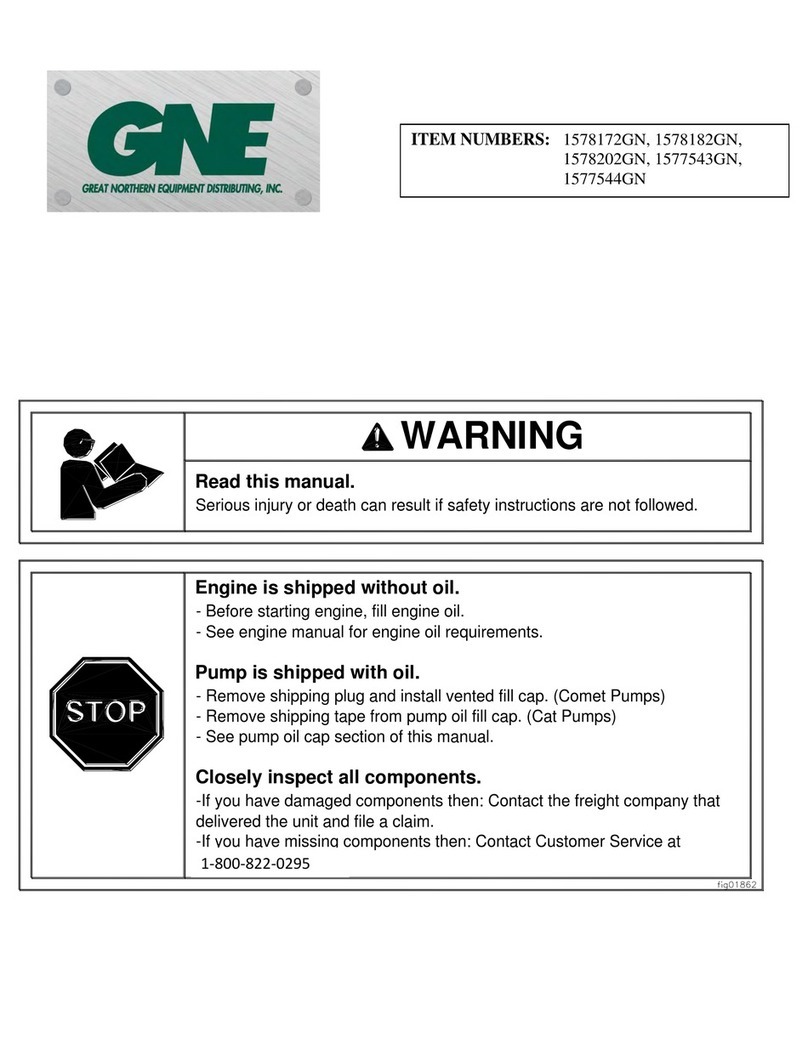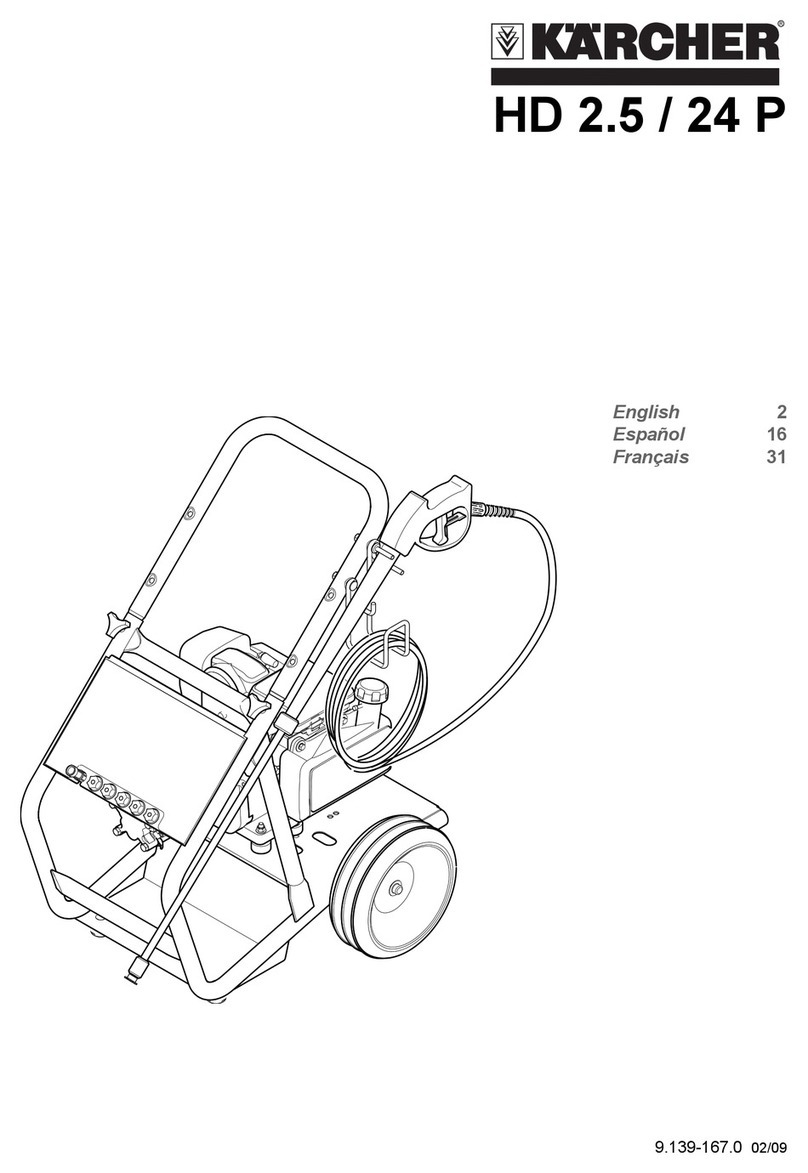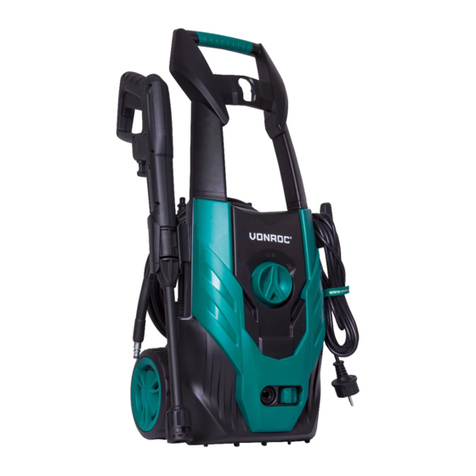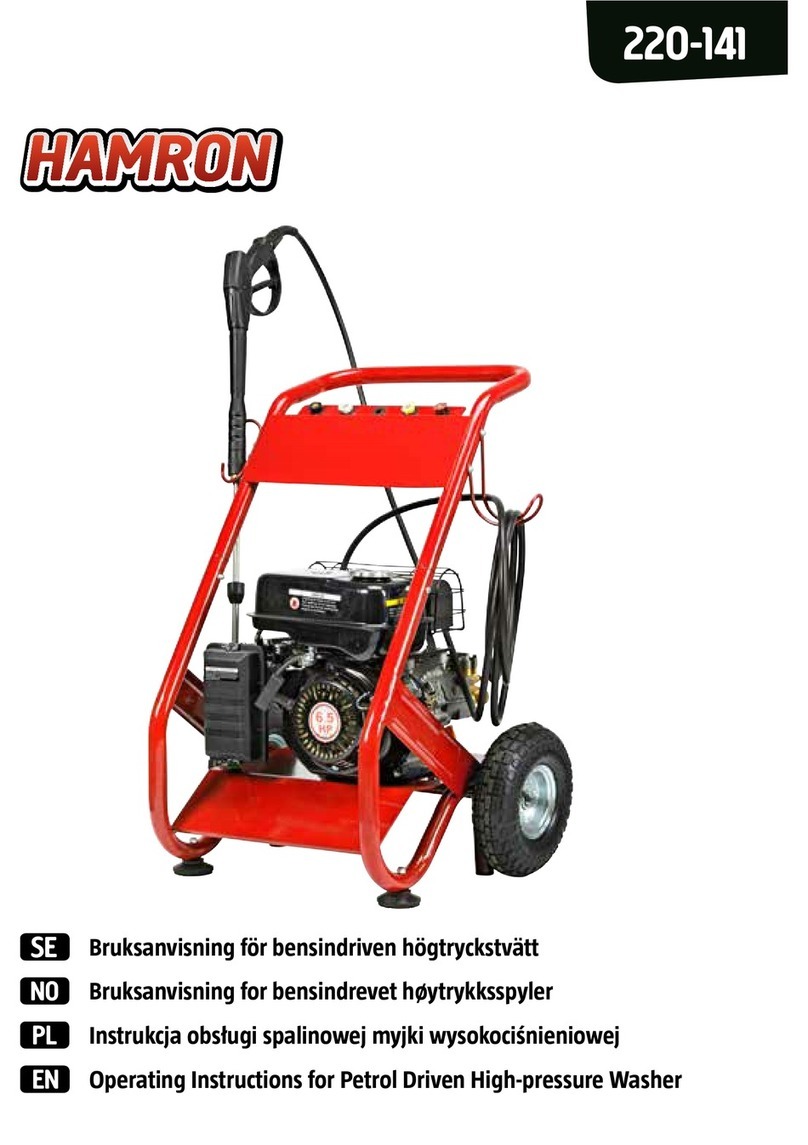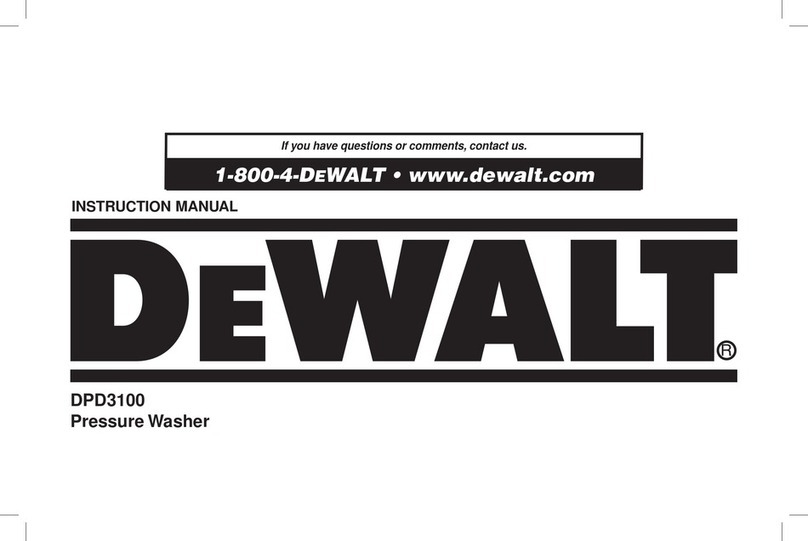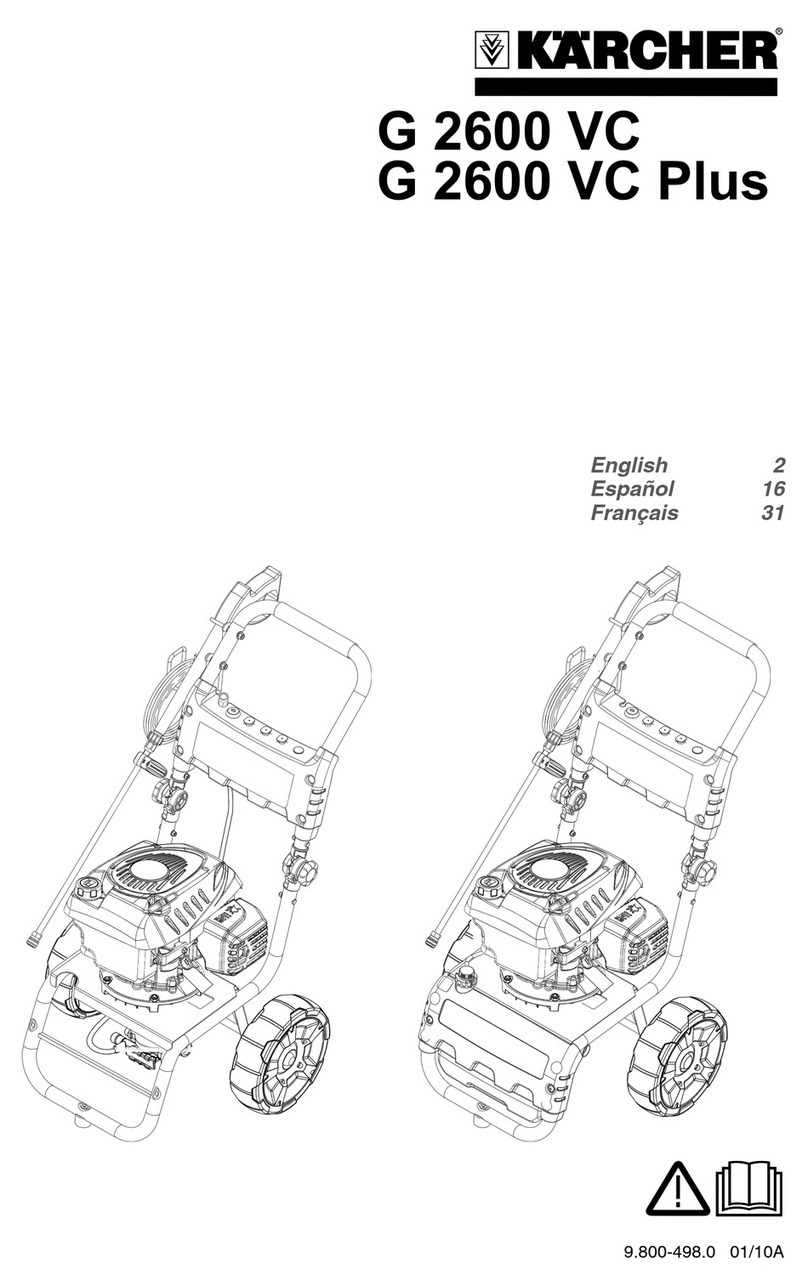GNE M157307GNA User manual

M157307GNA
Installation, Operation, and Maintenance Manual
HOT WATER PRESSURE WASHER:
Cleans dirty surfaces with high-pressure hot water.
To the Owner:
Thank you for purchasing a GNE hot water pressure washer. Your machine is designed for long life,
dependability, and the top performance you demand! Take time now to read through this manual so you will
better understand the machine’s operation, maintenance and safety precautions. Everyone who operates this
machine must read and understand this manual. The time you take now will prolong your machine’s life and
prepare you for its safe operation. Enjoy the exceptional performance of your GNE hot water pressure washer,
the industry leader! The manufacturer reserves the right to make improvements in design and/or changes in
specifications at any time without incurring any obligation to install them on units previously sold.
Quick Facts
Pump Oil
Pump is shipped with oil. Change oil plug and check pump oil level before starting.
Use non-detergent SAE 30 or Cat# 22158.
Water
Make sure your water flow is 20% higher than the pressure washer’s flow rate.
Make sure your water is clean and particle free.
Storage
Do not allow water to freeze in the pump, hose, coil, or spray gun.
Spraying
Chemicals
Use only quality pressure washer chemicals
Maintenance
Schedule
Pump Oil: change after first 50 hours, then every 3 months or 500 hours.
Read and understand all manuals before operating.
Any Questions, Comments, Problems or Parts Orders
GNE Product Support 1-800-822-0295
ITEM NUMBER: 157307
SERIAL NUMBER:
HP:______ Volts:______ Amp:______ Ph:_____
RPM:____ PSI:____ GPM:____ Nozzle Size:_____
Pump:___________ Hose:______ Lance:_______
Max. Discharge Temperature:_____________

2
Table of Contents
Important Safety Instructions
2
Safety Features
13
Grounding Instructions
3
Maintenance Instructions
13
Extension Cords
3
Moving and Handling Instructions
18
Specifications
4
Long Term Storage
18
Machine Component Identification
5
Troubleshooting
19
Installation Instructions
6
Parts Breakdowns
20
Operation Instructions
10
Wiring Diagram
23
Limited Warranty
29
Important Safety Instructions
WARNING -Risk of Injection or Injury to Persons - Do Not Direct Discharge Stream at Persons - Do not use a
hose if exterior damage is evident.
-Risk of explosion - Do not spray flammable liquids - Do not operate in a flammable environment.
CAUTION -Risk of Asphyxiation - Exhaust fumes are deadly. For outdoor use only. Avoid inhaling exhaust
fumes.
-Risk of fire. Do not add fuel when the product is operating or hot.
-Gun kicks back. Hold with both hands.
-To reduce the risk of injury, read operating instructions carefully before use.
WARNING - When using this product basic precautions should always be followed, including the following:
1.) Read all the instructions before using the product.
2.) To reduce the risk of injury, close supervision is necessary when the product is used near children. Do
not allow irresponsible use by children. Always stop the product and bleed pressures before leaving
unattended, disconnecting hoses, or servicing the pump.
3.) Know how to stop the product and bleed pressures quickly. Be thoroughly familiar with the controls.
4.) Stay alert - watch what you are doing.
5.) Do not operate the product when fatigued or under the influence of alcohol or drugs. Never smoke while
operating or fueling this machine.
6.) Keep operating area clear of all persons.
7.) Do not overreach or stand on unstable support. Keep good footing and balance at all times. Wear
footwear capable of maintaining a good grip on wet surfaces - Do not place the machine on soft or
unstable ground.
8.) Follow the maintenance instructions specified in all manuals. Do not run machine without sufficient
lubrication or sufficient water to cool the pump.
9.) Wear safety glasses, gloves, face protection and appropriate clothing when operating the machine.
10.)Do not operate this machine with broken or missing parts - Never alter the manufacturer’s original design
or deactivate any safety device on the machine.
11.)Risk of exposure to dangerous chemicals. Wear protective gloves when handling and cleaning with
chemicals. Follow the chemical manufacturer’s directions. Understand all safety hazards and first aid for
all chemicals being used. Check whether dangerous chemicals have been used and take any
precautions that may have been recommended by the supplier of these chemicals when cleaning filters.
Do not pump highly abrasive fluids or use with incompatible chemicals or solvents.
12.)Know the pressure and temperature limits of your machine. Be sure all high pressure accessories meet
or exceed your machine’s limits. Do not set the pressure relief valve above the machine’s limit.
13.)Do not move this machine by pulling on the hose. Do not use the pump to support other items of
equipment that impose unacceptable loads on the pump. Do not attempt to use this machine as a prop.
14.)To reduce risk of injury, do not secure the spray gun open. Your spray gun is equipped with a built-in
trigger safety latch to guard against accidental trigger release and potentially dangerous high pressure
spray. Rotate the safety latch to the locked position when not spraying.
15.) Do not clean this machine with its own spray. Cleaning should be done with a damp sponge with the
motor OFF.
16.) NEVER attempt to immediately run or re-light the burner if it doesn’t ignite the first time. Unburned oil or
gas may have accumulated causing potential explosion or fire hazard.
17.) Always make sure all switches and controls are in the OFF position prior to plugging in the electrical
cord. Do not stand in water while plugging and unplugging electrical cord.
18.) This product is provided with a ground fault circuit interrupter built into the power cord plug. If
replacement of the plug or cord is needed, use only identical replacement parts.

3
Grounding Instructions
This product must be grounded. If it should malfunction or breakdown, grounding provides a path of least resistance for
electric current to reduce the risk of electrical shock. This product is equipped with a cord having an equipment-grounding
conductor and a grounding plug. The plug must be plugged into an appropriate outlet that is properly installed and
grounded in accordance with all local codes and ordinances.
DANGER - Improper connection of the equipment - grounding conductor can result in a risk of electrocution. Check with a
qualified electrician or service personnel if you are in doubt as to whether the outlet is properly grounded. Do not modify
the plug provided with the product. If it will not fit the outlet, have a proper outlet installed by a qualified electrician. Do not
use any type adapter with this product.
1. For a product rated 125 volts or less:
GROUND FAULT CIRCUIT INTERRUPTER PROTECTION
This pressure washer is provided with a ground fault circuit interrupter (GFCI) built into the plug of the power supply cord.
This device provides additional protection from the risk of electric shock. Should replacement of the plug or cord become
necessary, use only identical replacement parts that include GFCI protection.
2. For a product rated more than 125 volts:
GROUND FAULT CIRCUIT INTERRUPTER PROTECTION
To comply with the National Electric Code (NFPA 70) and to provide additional protection from the risk of electric shock,
this pressure washer should only be connected to a receptacle that is protected by a ground fault circuit interrupter (GFCI).
Extension Cords
Use only 3-wire extension cords that have 3 prong grounding-type plugs and 3-pole cord connectors that accept the plug
from the product. Use only extension cords that are intended for outdoor use. These extension cords are identified by a
marking “Acceptable for use with outdoor appliances; store indoors while not in use.” Use only extension cords having an
electrical rating not less than the rating of the product. Do not abuse extension cord and do not yank on any cord to
disconnect. Keep cord away from heat and sharp edges. Always disconnect the extension cord from the receptacle before
disconnecting the product from the extension cord.
Warning - To reduce the risk of electrocution, keep all connections dry and off the ground. Do not touch plug with wet
hands.
SAVE THESE INSTRUCTIONS

4
Specifications
157307
Pressure Rating
2000 psi
Flow Output
1.5 gpm
Pump Type
Ceramic Triplex
Plunger
Water Supply
Standard tap water @
20-100psi
Motor Horsepower
2.0 hp
Maximum
Temperature
250F
Approved Fuels
#1 or 2 Diesel,
Kerosene, Fuel Oil
Fuel Capacity
8.25 gal.
Discharge Hose
3/8” x 50’
Power
Requirements
Dedicated NEMA
Receptacles
5-20R
Volts
115V
Amps
20A
Hertz
60Hz
Phase
single
Dimensions
Length
38”
Width
26”
Height
43”
Ship Weight
385 lb.

5
Machine Component Identification
157307
Ref #
Description
Ref #
Description
Ref #
Description
1
Exhaust Vent
10
Flow Switch
19
Fuel Filter
2
High Pressure Water Outlet
11
Tee
20
Quick Connector
3
Motor
12
Safety Relief Valve
21
Spray Gun
4
Burner
13
Pump
22
Grip
5
Fuel Fill Cap
14
Gun Hooks
23
Lance Wand
6
Fuel Tank
15
Power Switch
24
Power Cord Hangers
7
Control Box
16
Thermostat
25
High Pressure Hose Hanger
8
Elbow
17
Service Panel
26
Garden Hose Water Inlet
9
Swivel Fitting
18
Nozzles

6
Installation Instructions
I.) Unpack
Separate and identify all components. Use the assembly instructions in this manual for assembly.
High Pressure Hose
Qty-1
Wheel Retainer
Qty-2
Spray Gun & Grip
Qty-1
Wheel
Qty-2
Pressure Washer
Qty-1
Fastener Bag
Qty-1
Nozzle
Qty-6

7
II.) Assembly Instructions
A. 1. Carefully raise the pressure washer off the floor by
using blocks or ramps. Make sure the pressure
washer is secure before proceeding.
2. Install the two wheels as shown with grease zerk
away from frame.
3. Slide the two wheel retainers onto the end of the
axle. Tighten the setscrew with a hex wrench.
Description
Qty.
Wheel
2
Wheel Retainer
2
B. 1. Install the pressure hose onto the pressure washer
as shown.
2. Connect the other end of the pressure hose to the
spray gun as shown.
3. Make sure all plumbing connections are tight.
Description
Qty.
Spray Gun/ Lance
1
Spray Hose
1
Wheel Retainer
Wheel
Axle
Grease Zerk

8
III.) Pump Preparation
A.)Remove shipping tape from oil fill cap
B.)Make sure the oil is 1/2 way up oil sight glass.
*Universal Tractor Transmission Oil or Mobil 1 15W50
**SAE Non-Detergent (order Cat Pump Oil Item# 22158)
Quantities Of Fluid
Pump
Type of
Fluid
QTY
Cat 2DX
SAE 30**
8.5oz (0.25L)

9
V.) Getting Started
IMPORTANT: Proper initial installation of equipment
will assure more satisfactory performance, longer
service life and lower maintenance cost.
Make sure the pressure washer is on a level surface and
in a protected area where it is not readily influenced by
outside forces such as strong winds, freezing
temperatures, rain, etc. Locate the pressure washer for
easy access for filling fluids, adjustments and
maintenance.
It is recommended that a partition be made between the
wash area and the pressure washer to prevent direct
nozzle spray from coming in contact with the pressure
washer. Moisture reaching the equipment will reduce the
pressure washer’s service life.
V.) Venting
DANGER: Do not run machine indoors or in an
enclosed area without adequate ventilation or in
areas where flammable vapors (gasoline, solvents,
etc.) may be present. Do not vent exhaust gases into
a wall, a ceiling or a concealed space.
CAUTION: All venting must be in accordance with
applicable federal and state laws and local
ordinances. Consult local heating contractors.
Poor draft will cause the pressure washer to soot and not
operate properly. When selecting the location for
installation, beware of poorly ventilated locations or areas
where exhaust fans may cause an insufficient supply of
oxygen. Proper combustion can only be obtained when
there is a sufficient supply of oxygen available for the
amount of fuel being burned. If it is necessary to install a
unit in a poorly ventilated area, outside fresh air may
have to be piped to the burner and a fan installed to bring
sufficient air into the unit
VI.) Oil Burner
Burner Air Adjustment: The oil burner is preset and
performance tested at the factory (elevation 1100 feet).
A one-time initial correction of the burner for your
location will pay off in economy, performance and
extended service life.
1.) Turn the pump and heat switches on (Refer to
“Operation” for details). Have someone operate the
spray gun so the burner fires.
2.) Loosen the locking screw and close the air band until
black smoke appears from the burner exhaust vent.
Note the position of the white arrow on the air band.
3.) Slowly open the air band until white smoke just starts
to appear.
4.) Turn the air band half way back to the black smoke
position previously noted. Tighten the locking screw.
5.) Fine tune the burner air by loosening the shutter lock
screw and turning the shutter until the exhaust is
cleanest. Tighten the shutter lock screw.
CAUTION: If white smoke appears from the burner
exhaust vent during start-up or operation,
discontinue use and readjust air bands.
Partition
Locking
Screw
Air Band
Burner
White
Arrow
Shutter Lock
Screw
Shutter

10
Operating Instructions
Follow these instructions every time you use the pressure washer.
I.) Pre-Operation
A.) Position the machine for easy access to all
controls.
B.) Position the machine on a solid surface, with
less than a three degree slope and so it is
protected from external damage.
C.) Position the machine so that ambient lighting is
sufficient for the surface you are cleaning to be
seen with ease. Use artificial light if needed.
D.) Check hoses, fittings, wand, trigger gun and fuel
connections for signs of wear, cracks and
looseness and replace as required.
E.) Check and clean the nozzle orifice.
F.) Check and clean the water inlet screen and filter.
G.) Read entire manual, especially the important
safety instructions listed on page 2.
H.) Check and maintain proper oil level in the pump.
II.) Check Your Water Supply
A.) Make sure the water supply is clean. Debris can
cause excess pump wear and reduce
performance.
B.) An insufficient water supply will damage your
pump. Make sure the water supply is steady and
is 20% over the rated flow of your pump. Use a
stopwatch to time how long it takes to fill a 5
gallon bucket with your garden hose.
Example: If the rated flow is = 3 gpm
Then required flow = 3 x 1.20 = 3.6 gpm
5 gallons / 3.6 gpm = 1.39 minutes
1.39 min x 60 sec/min = 83 seconds
Therefore, you must be able to fill a
5 gallon bucket in 83 seconds or faster.
C.) The water supply garden hose must have an
inside diameter of at least 5/8”. If the hose is
more than 100 ft. long, the diameter must be at
least 3/4”.
D.) Never use a reservoir tank as a water source.
This pressure washer is designed for a
pressurized water source such as a city water
faucet. Sucking water out of a tank may cause
pump cavitation and damage to your pump.
However, the inlet pressure of the pump must
not exceed 115 psi (8 bar).
E.) Always use a flexible rubber hose for your water
supply. Do not use rigid piping.
F.) Do not pump flammable liquids or liquids
containing incompatible chemicals or solvents.
III.) Before Starting
WARNING: Make sure all switches and controls are
in the OFF position prior to plugging in the cord.
DO NOT stand in water while plugging or unplugging
electrical cord.
WARNING: Use a UL recognized receptacle
protected by a ground fault interrupter and
extension cord of proper voltage and amperage at all
times.
1. Connect electrical cord to specified NEMA receptacle.
See page 4.
WARNING: Check hoses, fittings, wand, trigger gun
and fuel connections daily for signs of wear, cracks
and looseness. Replace as required.
2. Connect water supply hose to the garden hose
connector located on the pump.
3. Fill the burner fuel tank. We recommend kerosene
because it burns cleanest. #1 grade home heating
oil, #1 or #2 diesel can also be used. DO NOT USE
GASOLINE OR CRANKCASE OIL.
4. If detergents will be used, only use detergents
intended for pressure washers. Follow instructions on
the detergent container.
IV.) To Start
DANGER: Do not point the spray wand at yourself or
at any person. Bodily injury may result from water
under high pressure.
WARNING: Wear eye, ear, hand, foot and skin
protection at all times while operating this pressure
washer.
IMPORTANT: The water must be turned on before
starting. Running the pump dry will cause damage
and void warranty.
1. Turn water supply ON.
2. Squeeze the trigger to allow air to purge from the
system. (This step goes faster with the pressure nozzle
removed)

11
V.) Attach Nozzle
Color of Nozzle:
Spray Angle
Used For:
Red
0
Highest Impact
Yellow
15
Tough Stains/
Stripping
Green
25
General
White
40
Light Cleaning
Yellow
15
Steaming
Black
65
Chemical
Your pressure washer is equipped with six nozzles. To
install a nozzle simply pull back the collar towards the
lance and push the nozzle into the coupler. Once the
connection is made, pull on the nozzle to assure a tight
connection.
WARNING: Make sure the nozzle is correctly
inserted. The nozzle may become a projectile if not
inserted correctly. Do not attempt to use different
types of nozzles that may not fit the coupler.
VI.) Turn the pump switch ON.
1. Make sure the hose is not kinked. A kinked hose
will provide insufficient water supply to the pump and
will reduce its life. Make sure the hose remains
unkinked after moving the pressure washer.
VII.) For Hot Water
1. If HOT water is desired, make sure there is fuel in
the fuel tank, turn the heat switch ON and adjust the
thermostat to the desired temperature. The burner
will fire when the trigger is squeezed. You may need
to initially adjust your burner for peak performance.
See the “Oil Burner” section under INSTALLATION.
When the trigger is released or the temperature
setting is reached, the burner will automatically turn
off.
IMPORTANT: Do not run the machine in hot mode
without any fuel in the fuel tank. The fuel pump will
be damaged if it is run dry.
To Clean
WARNING: Wear eye, ear, hand, foot and skin
protection at all times while operating this pressure
washer.
DANGER: Do not point the spray wand at yourself or
at any person. Bodily injury may result from water
under high pressure.
CAUTION: Be careful on painted or delicate surfaces.
The pressure may damage the surface if the nozzle
is too close.
IMPORTANT: Your spray gun is equipped with a
built-in trigger safety latch to guard against
accidental trigger actuation and potentially
dangerous high pressure spray. Rotate the safety
latch to the locked position when not spraying.
NOTE: Your pressure washer is equipped with a low
pressure chemical injector. You do not need to use
chemicals for every job, however, the proper
chemical used for the proper application can speed
up cleaning jobs tremendously.
WARNING: Only use high quality pressure washer
chemicals or chemicals specifically formulated for
pressure washers. Follow the chemical
manufacturer’s recommendations. Understand all
safety precautions and first aid for all chemicals.
1. Press the braided chemical hose over the chemical
injector on the pump and submerge the suction
strainer connected to the braided chemical hose into
the chemical solution.
Nozzle
Chemical
Injector
Braided Hose
and Strainer
Diluted
Chemical
CORRECT
INCORRECT
Nozzle
Collar
Coupler
Lance

12
2. The black, low-pressure chemical nozzle must be
used to spray chemicals.
3. Squeeze the spray gun trigger. The chemical injector
will draw the chemical into the water stream.
4. Spray detergent onto the surface and allow it to soak.
Chemicals need time to work properly. Follow the
chemical manufacturer’s recommendations for the
recommended time.
5. Change back to high pressure to rinse by inserting one
of the high-pressure nozzles.
6. Hold the lance with two hands in a sturdy stance
position.
7. Point lance at dirty surface and squeeze trigger.
8. Wash from the bottom to the top, using side-to-side
motions. This washes away heavy dirt and allows the
detergent to soak as you work toward the top.
9. Use the width of the spray pattern to wash in a wide
path. Overlap spray paths for complete coverage.
10.The nozzle should be 12” to 24” from the work, closer
for tough areas.
Caution: Be careful on painted or delicate surfaces,
the pressure may damage the surface if the nozzle is
too close.
11. Small parts should be washed in a basket so the
pressure does not push them away. Larger,
lightweight parts should be clamped down.
12. The pressure washer is set to the maximum rated
pressure when it leaves the factory. To adjust the
pressure, turn the unloader knob counter-clockwise.
WARNING: Do not alter the unloader valve’s
maximum pressure. Excess pressures could cause
serious injury and/or pump damage. Any alteration
other than turning the adjustment knob will void
your warranty.
For Steam (Optional)
1. Set the thermostat to 250F.
2. Turn the Heat switch ON.
3. Insert the steam nozzle into the nozzle holder.
To Stop
1. If detergents were used, draw clear water through the
detergent inlet line to purge detergent. Failure to do
so may clog the chemical injector.
2. If the burner was used, turn off the “Heat” switch and
pump cold water through the coil for 3 minutes.
Insufficient cool down period of high pressure hose
will cause excessive wear and eventual rupturing of
hose.
3. Turn the pump switch OFF.
4. Turn OFF the water supply.
5. Squeeze the trigger to relieve the system pressure.
Unloader

13
Safety Features
I.) Safety Relief
The safety relief valve is a backup safety feature. If the
unloader malfunctions, the safety relief valve will open
and relieve system pressure.
WARNING: If the safety relief valve ever discharges
water, turn the unit off and do not use the machine.
See a dealer or call Product Support at
1-800-822-0295.
II.) Thermostat
The adjustable thermostat is another safety feature. If
the discharge water reaches the desired temperature
setting, the burner will cycle off until the water
temperature is below the desired temperature setting
and then it cycles the burner back on for firing.
Maintenance Instructions
WARNING: Unauthorized machine modification or use of non-approved replacement parts may cause personal
injury and/or property damage and will void the manufacturer warranty.
All mechanical equipment, no matter how well designed, will need repairs. A GNE pressure washer is no exception. At
times, a GNE pressure washer may be inoperable because repairs are required. GNE Product Support will assist in these
repairs as needed, but if an inoperable pressure washer creates a major expense to your business then we strongly
recommend the following:
1. Have someone on staff who is trained in the operation of the pressure washer and is capable of making minor repairs
and performing all preventative maintenance procedures as outlined in the provided manuals.
2. Keep a stock of recommended service parts for maintenance and minor repairs.
Maintenance Mode
Before performing any maintenance on the pressure
washer, it must be placed in maintenance mode.
A.) Turn off water supply
B.) Bleed water from system
C.) Turn off and unplug power cord
Maintenance Schedule
What to Check
When To Check
What to Do
Fuel Filter
500 hrs
Change
Inlet Filter
Each Use
Clean
Tires
Each Use
Check Pressure
Hoses
Each Use
Check for Wear
Bolts
Each Use
Check for Loose
Bolts
00789
Safety
Relief
Note: Shield
not shown for
clarity
Thermostat

14
Cleaning The Inlet Filter
WARNING: Check whether dangerous chemicals have
been used and take precautions when handling filters.
A.) Unscrew clear tube by hand.
B.) Remove Inlet filter
C.) Run water though to clean filter
Checking the Tire Air Pressure
A.) Remove air fill cap
B.) Fill tire to 20psi (1.4bar)
C.) Replace air fill cap
Checking the Hoses
WARNING: Do not use a finger or skin to check for
leaks. Escaping fluid under pressure has sufficient
force to penetrate the skin, causing serious injury. Do
not operate the pressure washer if the hose is cracked,
worn or leaking.
A.) Check all hoses for leaks
B.) Check all hoses of worn areas
Changing The Pump Oil
*Change oil after first 50 hours, then every 3 months or 500
hours
1.) Remove oil drain plug
2.) Drain pump oil.
3.) Replace oil drain plug.
4.) Fill pump oil according to table below.
5.) Use sight glass to fill to proper level.
Quantities Of Fluid
Pump
Type of Fluid
QTY
CAT
SAE 30**
8.5 oz (0.25L)
**Non-Detergent Oil (order pump oil Item #22158)
Burner Fuel Filter
Drain water which has accumulated in the fuel filter
bowl and replace the filter as needed.
Filter
Water Drain
FIG02300
Air Fill Cap
Air Fill Stem
Good
Bad
Bad
Wire Mesh
Water
Filter
Water Drain
Oil Fill
Oil Drain Plug
(Underneath)
Cat
Pump

15
Coil Descaling
In hard water areas, scale build-up within the
heating coil will occur. Scale deposits will decrease
the water temperature rise and may eventually clog
the heating coil.
1. Mix scale remover in a 5 gallon bucket and
elevate the bucket so it is higher than the pump.
2. Attach the high pressure hose to the high
pressure water outlet on the machine. Do not
hook up the spray gun.
3. Place the other end of the high pressure hose in
the 5 gallon bucket.
4. Attach a short length of hose to the garden hose
inlet on the pump.
5. Prime the pump by filling the hose with water,
then place the end of the hose in the bucket.
6. Run the pressure washer in cold mode for 1 to 3
hours recirculating the cleaning solution.
Warning: Do not run the burner.
7. Dispose of the cleaning solution where it is not
harmful to animals or the environment.
8. Flush with fresh water and clean the inlet
strainer when finished.
Coil Desooting
Poor grades of fuel oil or inadequate combustion
air will cause heavy soot build-up on the outside
surface of the heating coil. These deposits will
insulate the coil. This will restrict the air flow
through the coil, further aggravating the soot build-
up.
Most coils will never require desooting. However,
to desoot a coil...
1. Wear protective clothing, goggles, and gloves.
2. Remove the fittings from the inlet and outlet of
the coil.
3. Remove the lid from the heating chamber and
hoist the coil out. Be careful, the coil is very
heavy.
Important: Be careful not to damage the
threads on the coil inlet and outlet. If the
threads get damaged, it will be hard to
reconnect and seal the fittings on the coil inlet
and outlet.
4. Clean the coil.
5. Reassemble the coil to the machine. Make sure
the white insulation remains in place.
6. Make sure all fittings are tight before using the
machine. Use thread sealant on all threads.
Clean Inlet Strainer
When Finished
00791
Heating Coil
Heating Chamber
Short High
Pressure Hose
00792
Insulation Cap
Lid

16
Electrodes
On a yearly basis the electrodes should be
inspected and any necessary adjustments made.
1. Tip the machine back until it rests on the frame.
2. Remove the 4 nuts that attach the burner to the
heating chamber. You do not have to disconnect
the fuel lines or the electric co
3. Let the burner fall away from the heat
exchanger.
4. Clean off carbon deposits, which may have
accumulated on the tips of the electrodes.
5. Reset the spacing as shown below.
4 Nuts
00793
00794
1/16”
1/8”
5/16”
Electrodes

17
Cleaning Instructions for Flow Switch on 157307
Mineral build-up and/or debris within the flow switch can occur and may affect burner operation if not
periodically cleaned. Mineral build-up and/or debris can stop the movement of the shuttle inside the flow
switch body. Shuttle movement is important because the burner will not fire if the shuttle does not move. The
shuttle movement actuates a switch inside the flow switch housing which allows the burner to fire during spray
mode.
Inspect and clean the flow switch as needed
1) Disconnect the swivel fitting from elbow to
the inlet of the coil
2) Disconnect the whole flow switch assembly
including the swivel and removable outlet
fitting where the brass body connects to
hose or tee depending on model
3) Unthread the removable outlet fitting with
the swivel still attached from the flow
switch assembly
4) Remove the shuttle
5) Clean the inside of the brass flow switch
body and the shuttle with water and a soft
brush
6) Insert the shuttle into the brass flow switch
in the orientation shown
Note: Aligning the male tabs on
the shuttle to the female guides
inside the brass flow switch body
can be difficult since the shuttle is
magnetic
7) Thread the removable outlet fitting with the
swivel still attached into the flow switch
assembly
8) Thread the brass flow switch body onto the
incoming water flow source (hose or tee)
depending on the model
9) Reconnect the swivel fitting to the inlet of
the coil
Removable
Outlet Fitting
Brass Body
Swivel
Fitting
Shuttle Alignment
Shuttle
male tabs
Shuttle
Swivel
Fitting
Removable
Outlet
Fitting
Flow Switch
Assembly
Brass Flow
Switch Body
female guides

18
Moving and Handling Instructions
Maneuvering Your Pressure Washer
1.) Pull the handle back with both hands.
2.) Rotate the handle downward to a comfortable height.
3.) Push the pressure washer forward as you walk.
Lifting Your Pressure Washer
1.) To reduce risk of injury, it is recommended to use a
hoist to lift this pressure washer.
2.) Lift from lifting point (see picture)
Long Term Storage
During cold weather, store the pressure washer indoors and move it outdoors before starting.
Follow these instructions to prevent the pump from freezing during storage.
Winter Storage:
Items needed: 12” piece of garden hose or equivalent,
funnel and RV antifreeze (approximately 2 gallons).
1.) Attach the garden hose with funnel to the pump inlet
(see illustration).
2.) Pour RV antifreeze into the funnel.
3.) Turn the unit on and make sure the burner is off.
4.) Let the pump run no more than 15 seconds at a time
until antifreeze comes out the high pressure outlet.
5.) It will take about 1.5 gallons of antifreeze to fill the
pump and heat exchanger coil.
6.) Drain all water from the high pressure hose. Depress
trigger on gun and drain all water out of gun/lance.
Lift Here
Handle
RV Antifreeze
Water Inlet
Hose
Funnel

19
Troubleshooting Guide
Pressure Washer Will Not Run - No Power
Causes
Solutions
Machine not plugged in
Plug machine in
GFCI tripped
Make sure machine is dry
Press RESET on the GFCI
Machine turned OFF
Turn Pump switch ON
Line circuit breaker tripped
Check for tripped circuit breaker in building
Circuit Breaker Trips During Operation
Causes
Solutions
Voltage too low
Check the voltage
Circuit Breaker Overloaded
Make sure to use NEMA specified receptacle
Make sure there is no other equipment using the same circuit
- see Specifications
Pressure set too high
Check/adjust pressure setting on unloader
Pressure Washer Runs But No Pressure
Causes
Solutions
Partially clogged or damaged nozzle
Clean or replace nozzle
Low water flow
Make sure the water supply is more than the required flow
Pressure Washer Surges Or Cycles While In Bypass
Causes
Solutions
Leak between pump and gun
Check all connections between pump and gun for leaks
Tighten loose components and replace damaged components
Gun leaking internally
Replace spray gun
Smoke From Heat Exchanger
Causes
Solutions
Air band not adjusted properly due to different
elevation
Adjust the air band until the burner burns cleanly
See Oil Burner under Installation Instructions
Poor quality fuel
Use Kerosene for the cleanest burn
Water Not Heating Sufficiently
Causes
Solutions
Scale build-up in coil
See Coil Descaling under Maintenance Instructions
Coil is full of soot
See Coil Desooting under Maintenance Instructions
Safety Relief Valve Sprays Water
Causes
Solutions
Unloader/Burner Control Problem
Call Product Support
Poor Or No Detergent Supply
Causes
Solutions
Inadequate detergent supply
Refill detergent container
Make sure the chemical strainer is fully submerged
High pressure hose too long
Use less hose
Move machine closer to the work
Chemical strainer or injector clogged
Clean the strainer and injector. Always start with a clean detergent
container. Run clean water through the injector after each use.

20
157307- Rev A
Parts Breakdown
This manual suits for next models
1
Table of contents
Other GNE Pressure Washer manuals
